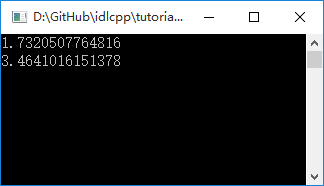C++混合编程之idlcpp教程Lua篇(8)
2016-05-11 00:02
417 查看
上一篇在这 C++混合编程之idlcpp教程Lua篇(7)
第一篇在这 C++混合编程之idlcpp教程(一)
与前面的工程相似,工程LuaTutorial6中,同样加入了四个文件:LuaTutorial6.cpp, Tutorial6.cpp, Tutorial6.i, tutorial6.lua。其中LuaTutorial6.cpp的内容基本和LuaTutorial5.cpp雷同,不再赘述。
首先看一下Tutorial6.i的内容:
struct Vector3<N>
这是一个模板类,C++的模板功能复杂强大,编译器实在难写。所以大多数C++模板的高级特性在idlcpp中都没有做支持,毕竟idlcpp只负责对脚本语言提供接口,有一些简单的模板功能就够用了。另外由于不准备支持数值做为模板参数,只支持类型做为模板参数,所以语法采用了c#的形式。与C++的模板语法不太一样。
static Vector3 s_zero;
这一行声明了一个静态成员变量。idlcpp支持静态成员变量,静态成员函数,静态属性(实际上也是静态成员函数)。
nocode N x;
nocode N y;
nocode N z;
nocode N v[$3];
$*
union
{
struct
{
N x,y,z;
};
N v[3];
};
*$
idlcpp 没有提供 union。好在可以通过nocode 和 $**$ 分别在生成的元数据描述代码和C++头文件提供各自的内容。
下面两行代码
export Vector3<float>;
export Vector3<double>;
用于生成元数据代码。idlcpp中通过这样的声明语句才会生成相应类型的元数据信息。
再下面两行代码
typedef Vector3<float> Vector3f;
typedef Vector3<double> Vector3d;
为模板类实例类型声明了类型别名。因为这两个类型名分别是::tutorial::Vector3<float> 和 ::tutorial::Vector3<double>,在脚本中使用不方便,有了类型别名之后就可以通过::tutorial::Vector3f和::tutorial::Vector3d来使用。
后面就是成员函数的实现代码,不在赘述。
编译后生成的Tutorial6.h的内容如下:
idlcpp会为只读属性length和lengthSquare 生成对应的函数声明get_length和get_lengthSquare。
其他的内容,C++和idl基本上都是一样的。
然后是Tutorial6.cpp
因为模板类的代码都写在头文件中了,所以Tutorial6.cpp只需要包含对应的四个文件即可。
最后看一下Tutorial6.lua的内容
编译执行,结果如下图:

第一篇在这 C++混合编程之idlcpp教程(一)
与前面的工程相似,工程LuaTutorial6中,同样加入了四个文件:LuaTutorial6.cpp, Tutorial6.cpp, Tutorial6.i, tutorial6.lua。其中LuaTutorial6.cpp的内容基本和LuaTutorial5.cpp雷同,不再赘述。
首先看一下Tutorial6.i的内容:
#import "../../paf/src/pafcore/typedef.i"
namespace tutorial
{
struct Vector3<N>
{
Vector3();
Vector3(const Vector3& v);
Vector3(N a, N b, N c);
Vector3(const N* p);
N getLength();
N length get;
N lengthSquare get;
static Vector3<N> s_zero;
nocode N x;
nocode N y;
nocode N z;
nocode N v[$3];
$*
union
{
struct
{
N x,y,z;
};
N v[3];
};
*$
};
export Vector3<float>;
export Vector3<double>;
typedef Vector3<float> Vector3f;
typedef Vector3<double> Vector3d;
$*
template<typename N>
Vector3<N> Vector3<N>::s_zero(0, 0, 0);
template<typename N>
inline Vector3<N>::Vector3()
{
}
template<typename N>
inline Vector3<N>::Vector3(const Vector3<N>& v) : x(v.x), y(v.y), z(v.z)
{}
template<typename N>
inline Vector3<N>::Vector3(N a, N b, N c) : x(a), y(b), z(c)
{}
template<typename N>
inline Vector3<N>::Vector3(const N* p) : x(p[0]), y(p[1]), z(p[2])
{}
template<typename N>
inline N Vector3<N>::getLength()
{
return N(sqrt(x * x + y * y + z * z));
}
template<typename N>
inline N Vector3<N>::get_length()
{
return N(sqrt(x * x + y * y + z * z));
}
template<typename N>
inline N Vector3<N>::get_lengthSquare()
{
return (x * x + y * y + z * z);
}
*$
}struct Vector3<N>
这是一个模板类,C++的模板功能复杂强大,编译器实在难写。所以大多数C++模板的高级特性在idlcpp中都没有做支持,毕竟idlcpp只负责对脚本语言提供接口,有一些简单的模板功能就够用了。另外由于不准备支持数值做为模板参数,只支持类型做为模板参数,所以语法采用了c#的形式。与C++的模板语法不太一样。
static Vector3 s_zero;
这一行声明了一个静态成员变量。idlcpp支持静态成员变量,静态成员函数,静态属性(实际上也是静态成员函数)。
nocode N x;
nocode N y;
nocode N z;
nocode N v[$3];
$*
union
{
struct
{
N x,y,z;
};
N v[3];
};
*$
idlcpp 没有提供 union。好在可以通过nocode 和 $**$ 分别在生成的元数据描述代码和C++头文件提供各自的内容。
下面两行代码
export Vector3<float>;
export Vector3<double>;
用于生成元数据代码。idlcpp中通过这样的声明语句才会生成相应类型的元数据信息。
再下面两行代码
typedef Vector3<float> Vector3f;
typedef Vector3<double> Vector3d;
为模板类实例类型声明了类型别名。因为这两个类型名分别是::tutorial::Vector3<float> 和 ::tutorial::Vector3<double>,在脚本中使用不方便,有了类型别名之后就可以通过::tutorial::Vector3f和::tutorial::Vector3d来使用。
后面就是成员函数的实现代码,不在赘述。
编译后生成的Tutorial6.h的内容如下:
//DO NOT EDIT THIS FILE, it is generated by idlcpp
//http://www.idlcpp.org
#pragma once
namespace tutorial
{
template<typename N>
struct Vector3
{
public:
Vector3();
Vector3(const Vector3& v);
Vector3(N a,N b,N c);
Vector3(const N* p);
N getLength();
N get_length();
N get_lengthSquare();
static Vector3<N> s_zero;
union
{
struct
{
N x,y,z;
};
N v[3];
};
};
typedef Vector3<float> Vector3f;
typedef Vector3<double> Vector3d;
template<typename N>
Vector3<N> Vector3<N>::s_zero(0, 0, 0);
template<typename N>
inline Vector3<N>::Vector3()
{
}
template<typename N>
inline Vector3<N>::Vector3(const Vector3<N>& v) : x(v.x), y(v.y), z(v.z)
{}
template<typename N>
inline Vector3<N>::Vector3(N a, N b, N c) : x(a), y(b), z(c)
{}
template<typename N>
inline Vector3<N>::Vector3(const N* p) : x(p[0]), y(p[1]), z(p[2])
{}
template<typename N>
inline N Vector3<N>::getLength()
{
return N(sqrt(x * x + y * y + z * z));
}
template<typename N>
inline N Vector3<N>::get_length()
{
return N(sqrt(x * x + y * y + z * z));
}
template<typename N>
inline N Vector3<N>::get_lengthSquare()
{
return (x * x + y * y + z * z);
}
}idlcpp会为只读属性length和lengthSquare 生成对应的函数声明get_length和get_lengthSquare。
其他的内容,C++和idl基本上都是一样的。
然后是Tutorial6.cpp
#include "Tutorial6.h" #include "Tutorial6.mh" #include "Tutorial6.ic" #include "Tutorial6.mc"
因为模板类的代码都写在头文件中了,所以Tutorial6.cpp只需要包含对应的四个文件即可。
最后看一下Tutorial6.lua的内容
v1 = paf.tutorial.Vector3f(1,1,2); v1.z = 1; print(v1.length._); v2 = paf.tutorial.Vector3d(2,2,1); v2.v[2] = 2; print(v2:getLength()._);
编译执行,结果如下图:

相关文章推荐
- leetcode.150. Evaluate Reverse Polish Notation
- Lua 垃圾收集机制
- 2dx-lua quick打包去掉蓝色启动页
- 150. Evaluate Reverse Polish Notation
- 2dx-lua精灵置灰
- [LeetCode]题解(python):150-Evaluate Reverse Polish Notation
- Lua和C++交互详细总结
- lua之alter提示框
- 实现c++,java,lua 在c++编写后需要在 pkg 文件中添加新的函数 然后批处理下生成GamePlatformToLua
- 在实现安卓和ios的sdk中 c++,java,lua 混编学习记录
- LuaDoc 3.0.1 Lua源代码文档生成工具(转)
- lua 随机数
- 基于ngx_lua_waf模块配置web应用防火墙
- 快速掌握Lua 5.3 —— 调试库 (2)
- 快速掌握Lua 5.3 —— 调试库 (1)
- 快速掌握Lua 5.3 —— userdata (2)
- 快速掌握Lua 5.3 —— userdata (1)
- lua类的继承
- lua基本实验
- lua 中的上n级模块路径函数分享
